
- •Study Skills Workshop
- •1.1 An Introduction to the Whole Numbers
- •1.2 Adding Whole Numbers
- •1.3 Subtracting Whole Numbers
- •1.4 Multiplying Whole Numbers
- •1.5 Dividing Whole Numbers
- •1.6 Problem Solving
- •1.7 Prime Factors and Exponents
- •1.8 The Least Common Multiple and the Greatest Common Factor
- •1.9 Order of Operations
- •THINK IT THROUGH Education Pays
- •2.1 An Introduction to the Integers
- •THINK IT THROUGH Credit Card Debt
- •2.2 Adding Integers
- •THINK IT THROUGH Cash Flow
- •2.3 Subtracting Integers
- •2.4 Multiplying Integers
- •2.5 Dividing Integers
- •2.6 Order of Operations and Estimation
- •Cumulative Review
- •3.1 An Introduction to Fractions
- •3.2 Multiplying Fractions
- •3.3 Dividing Fractions
- •3.4 Adding and Subtracting Fractions
- •THINK IT THROUGH Budgets
- •3.5 Multiplying and Dividing Mixed Numbers
- •3.6 Adding and Subtracting Mixed Numbers
- •THINK IT THROUGH
- •3.7 Order of Operations and Complex Fractions
- •Cumulative Review
- •4.1 An Introduction to Decimals
- •4.2 Adding and Subtracting Decimals
- •4.3 Multiplying Decimals
- •THINK IT THROUGH Overtime
- •4.4 Dividing Decimals
- •THINK IT THROUGH GPA
- •4.5 Fractions and Decimals
- •4.6 Square Roots
- •Cumulative Review
- •5.1 Ratios
- •5.2 Proportions
- •5.3 American Units of Measurement
- •5.4 Metric Units of Measurement
- •5.5 Converting between American and Metric Units
- •Cumulative Review
- •6.2 Solving Percent Problems Using Percent Equations and Proportions
- •6.3 Applications of Percent
- •6.4 Estimation with Percent
- •6.5 Interest
- •Cumulative Review
- •7.1 Reading Graphs and Tables
- •THINK IT THROUGH The Value of an Education
- •Cumulative Review
- •8.1 The Language of Algebra
- •8.2 Simplifying Algebraic Expressions
- •8.3 Solving Equations Using Properties of Equality
- •8.4 More about Solving Equations
- •8.5 Using Equations to Solve Application Problems
- •8.6 Multiplication Rules for Exponents
- •Cumulative Review
- •9.1 Basic Geometric Figures; Angles
- •9.2 Parallel and Perpendicular Lines
- •9.3 Triangles
- •9.4 The Pythagorean Theorem
- •9.5 Congruent Triangles and Similar Triangles
- •9.6 Quadrilaterals and Other Polygons
- •9.7 Perimeters and Areas of Polygons
- •THINK IT THROUGH Dorm Rooms
- •9.8 Circles
- •9.9 Volume
- •Cumulative Review
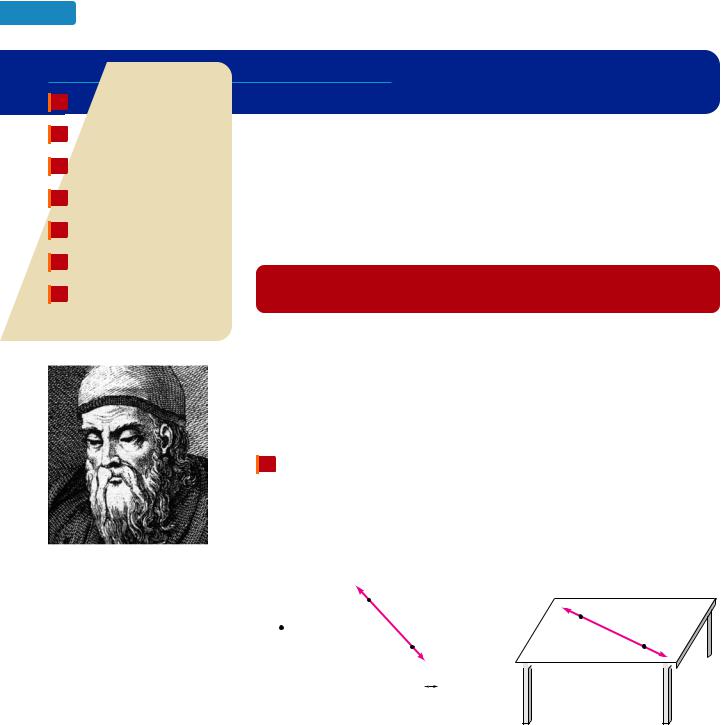
712 |
Chapter 9 An Introduction to Geometry |
Objectives
1Identify and name points, lines, and planes.
2Identify and name line segments and rays.
3Identify and name angles.
4Use a protractor to measure angles.
5Solve problems involving adjacent angles.
6Use the property of vertical angles to solve problems.
7Solve problems involving complementary and supplementary angles.
© INTERFOTO/Alamy
S E C T I O N 9.1
Basic Geometric Figures; Angles
Geometry is a branch of mathematics that studies the properties of twoand threedimensional figures such as triangles, circles, cylinders, and spheres. More than 5,000 years ago, Egyptian surveyors used geometry to measure areas of land in the flooded plains of the Nile River after heavy spring rains. Even today, engineers marvel at the Egyptians’ use of geometry in the design and construction of the pyramids. History records many other practical applications of geometry made by Babylonians, Chinese, Indians, and Romans.
The Language of Mathematics The word geometry comes from the Greek words geo (meaning earth) and metron (meaning measure).
Many scholars consider Euclid (330?–275? BCE) to be the greatest of the Greek mathematicians. His book The Elements is an impressive study of geometry and number theory. It presents geometry in a highly structured form that begins with several simple assumptions and then expands on them using logical reasoning. For more than 2,000 years, The Elements was the textbook that students all over the world used to learn geometry.
1 Identify and name points, lines, and planes.
Geometry is based on three undefined words: point, line, and plane. Although we will make no attempt to define these words formally, we can think of a point as a geometric figure that has position but no length, width, or depth. Points can be represented on paper by drawing small dots, and they are labeled with capital letters. For example, point A is shown in figure (a) below.
Point |
Line |
|
H |
Plane |
|||
|
|
|
|
|
|
I |
|
B |
|
|
|
E |
|
||
|
|
|
|
|
|||
A |
|
|
|
F |
|
|
|
|
|
|
|
|
|
||
Points are labeled |
C |
G |
|
|
|
|
|
with capital letters. |
|
|
|
|
|
|
|
|
|
|
|
|
|
||
(a)Line BC is written as BC
(b)
(c)
Lines are made up of points. A line extends infinitely far in both directions, but has no width or depth. Lines can be represented on paper by drawing a straight line
with arrowheads at either end. We can name a line using any two points on the line. In
·
figure (b) above, the line that passes through points B and C is written as BC. Planes are also made up of points.A plane is a flat surface, extending infinitely far
in every direction, that has length and width but no depth. The top of a table, a floor,
or a wall is part of a plane. We can name a plane using any three points that lie in the
·
plane. In figure (c) above, EF lies in plane GHI.
·
As figure (b) illustrates, points B and C determine exactly one line, the line BC.
·
In figure (c), the points E and F determine exactly one line, the line EF. In general, any two different points determine exactly one line.
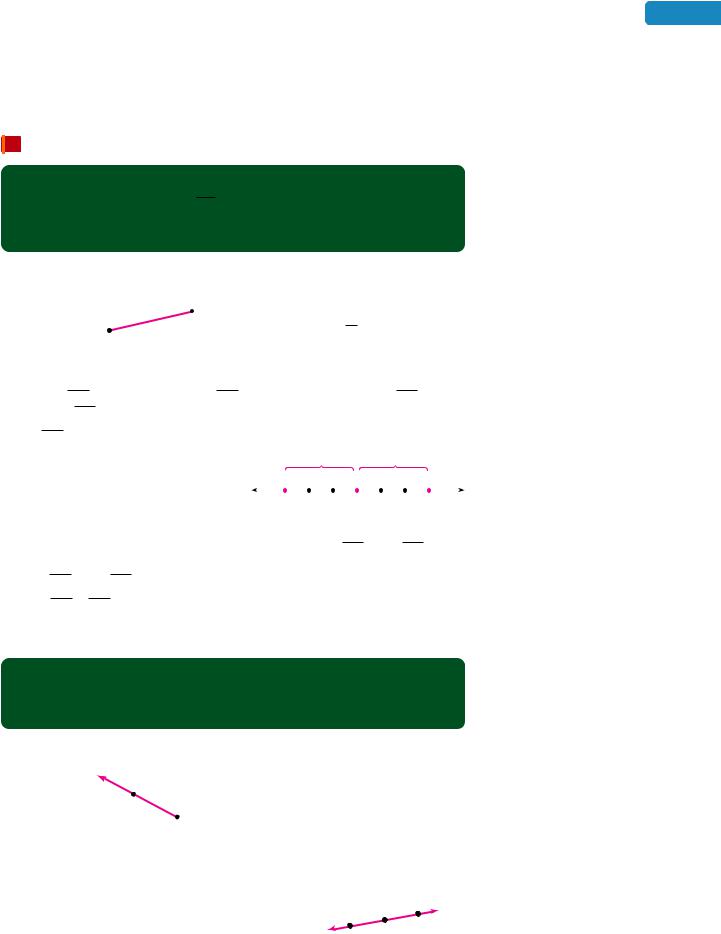
9.1 Basic Geometric Figures; Angles |
713 |
As figure (c) illustrates, points G, H, and I determine exactly one plane. In general, any three different points determine exactly one plane.
Other geometric figures can be created by using parts or combinations of points, lines, and planes.
2 Identify and name line segments and rays.
Line Segment
The line segment AB, written as AB, is the part of a line that consists of points A and B and all points in between (see the figure below). Points A and B are the endpoints of the segment.
Line segment
B
A
Line segment AB is written as AB.
Every line segment has a midpoint, which divides the segment into two parts of equal length. In the figure below, M is the midpoint of segment AB, because the measure of AM, which is written as m(AM), is equal to the measure of MB which is written as m(MB).
m(AM) 4 1
3 |
|
3 units |
|
3 units |
||
and |
A |
|
M |
B |
||
m( |
|
) 7 4 |
1 |
2 3 |
4 |
5 6 7 |
MB |
||||||
3 |
|
|
|
|
||
Since the measure of both segments is 3 units, we can write m(AM) m(MB).
When two line segments have the same measure, we say that they are congruent.
Since m(AM) m(MB), we can write
AM MB Read the symbol as “is congruent to.”
Another geometric figure is the ray, as shown below.
Ray
A ray is the part of a line that begins at some point (say, A) and continues forever in one direction. Point A is the endpoint of the ray.
Ray
B
→
A Ray AB is written as AB. The endpoint of the ray is always listed first.
To name a ray, we list its endpoint and then one other point on the ray. Sometimes
it is possible to name a ray in more than one way. For example, in the figure on the |
|||||
¡ |
¡ |
|
|
|
|
right, DE and DF name the same ray. This is because both have point D as their |
|||||
endpoint and extend forever in the same direction. In |
|
|
|
||
¡ |
¡ |
|
|
|
|
contrast, DE and ED are not the same ray. They have |
|
E |
F |
||
different endpoints and point in opposite directions. |
D |
||||
|
|||||
|
|
||||
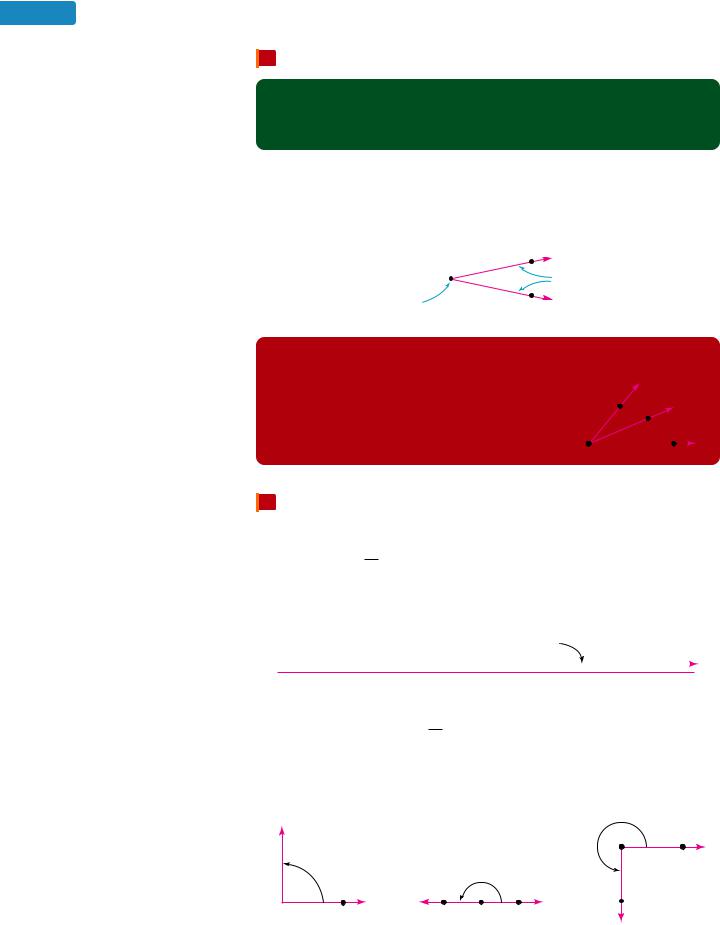
714 |
Chapter 9 An Introduction to Geometry |
3 Identify and name angles.
Angle
An angle is a figure formed by two rays with a common endpoint. The common endpoint is called the vertex, and the rays are called sides.
The angle shown below can be written as BAC, CAB, A, or 1. The symbolmeans angle.
|
Angle |
|
|
|
|
B |
|
A |
1 |
Sides of |
|
the angle |
|||
Vertex of |
|
||
|
C |
||
the angle |
|
Caution! When using three letters to name an angle, be sure the letter name
of the vertex is the middle letter. Furthermore, we can only name an angle |
||||
using a single vertex letter when there is no possibility |
|
|
|
|
|
|
|
||
of confusion. For example, in the figure on the right, |
|
W |
||
we cannot refer to any of the angles as simply X, |
|
|||
|
Y |
|||
because we would not know if that meant WXY, |
|
|||
X |
|
|
||
WXZ, or YXZ. |
|
|
||
Z |
||||
|
||||
4 Use a protractor to measure angles.
One unit of measurement of an angle is the degree. The symbol for degree is a small raised circle, °. An angle measure of 1° (read as “one degree”) means that one side of an angle is rotated 3601 of a complete revolution about the vertex from the other side of the angle. The measure of ABC, shown below, is 1°. We can write this in symbols as m( ABC) 1°.
1
This side of the angle is rotated ––– of a complete
360
revolution from the other side of the angle.
A
B 


 1° C
1° C
The following figures show the measures of several other angles. An angle measure of 90° is equivalent to 36090 14 of a complete revolution.An angle measure of 180° is equivalent to 180360 12 of a complete revolution, and an angle measure of 270° is equivalent to 270360 34 of a complete revolution.
m( FED) 90°
D 
90°
E 
F
m( IHG) 180° |
m( JKL) 270° |
270°
J
K
180°
L 
G H I
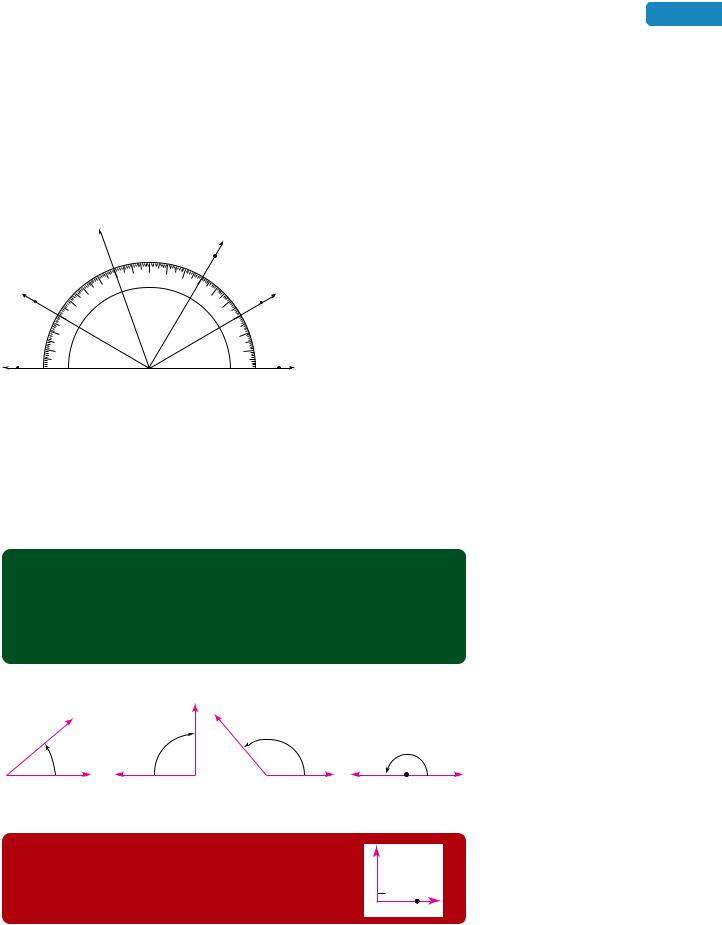
9.1 Basic Geometric Figures; Angles |
715 |
We can use a protractor to measure angles. To begin, we place the center of the protractor at the vertex of the angle, with the edge of the protractor aligned with one side of the angle, as shown below. The angle measure is found by determining where the other side of the angle crosses the scale. Be careful to use the appropriate scale, inner or outer, when reading an angle measure.
If we read the protractor from right to left, using the outer scale, we see that m( ABC) 30°. If we read the protractor from left to right, using the inner scale, we can see that m( GBF) 30°.
F
G
 E
E
140
|
160 |
150 |
30 |
|
20 |
|
|
170 |
10 |
|
|
180 |
0 |
|
|
130 50
40
120 60
110 70
100 80
|
|
|
|
D |
90 |
80 |
70 |
|
|
|
100 |
|
|
|
|
110 |
60 |
|
|
|
|
|
||
|
|
|
120 |
50 |
|
|
|
|
130 |
|
|
|
|
40 |
|
|
|
|
140 |
|
130 |
|
|
50 |
|
|
20 |
|
|
160 |
|
|
17 |
0 |
|
1 |
|
|
0 |
|
B |
180 |
0 |
|
|
|
|
|
Measure |
|
|
Angle |
in degrees |
|
|
|
|
|
|
ABC |
30° |
|
|
ABD |
60° |
|
C |
ABE |
110° |
|
ABF |
150° |
||
|
|||
|
ABG |
180° |
|
A |
GBF |
30° |
|
GBC |
150° |
||
|
|||
|
|
|
When two angles have the same measure, we say that they are congruent. Since m( ABC) 30° and m( GBF) 30°, we can write
ABC GBF Read the symbol as “is congruent to.”
We classify angles according to their measure.
Classifying Angles
Acute angles: Angles whose measures are greater than 0° but less than 90°.
Right angles: Angles whose measures are 90°.
Obtuse angles: Angles whose measures are greater than 90° but less than 180°.
Straight angles: Angles whose measures are 180°.
|
|
130° |
180° |
|
90° |
|
|
40° |
|
|
|
|
|
|
|
Acute angle |
Right angle |
Obtuse angle |
Straight angle |
The Language of Mathematics A symbol is often used to label a right angle. For example, in the figure on the right, the symbol drawn near the vertex of ABC indicates that m( ABC) 90°.
A
B

C
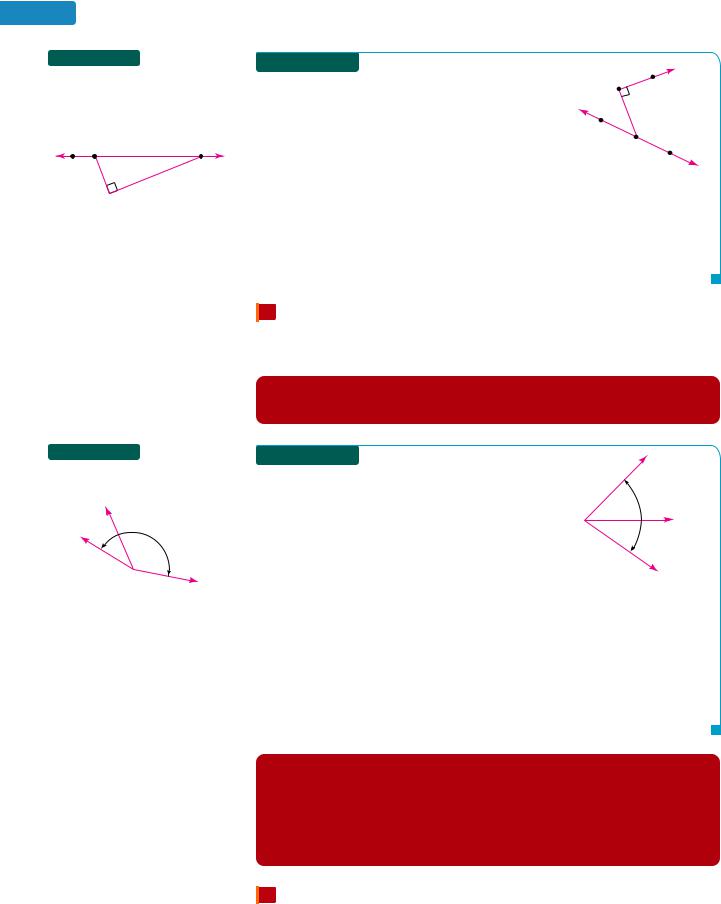
716 |
Chapter 9 An Introduction to Geometry |
 Self Check 1
Self Check 1
Classify EFG, DEF, 1, andGED in the figure as an acute angle, a right angle, an obtuse angle, or a straight angle.
D E G
1
F
Now Try Problems 57, 59, and 61
|
EXAMPLE 1 |
Classify each angle in the figure as |
E |
an acute angle, a right angle, an obtuse angle, or a straight |
D |
||
angle. |
|
|
|
Strategy We will determine how each angle’s measure |
A |
1 |
|
2 |
|||
compares to 90° or to 180°. |
|
||
|
B |
||
|
|
WHY Acute, right, obtuse, and straight angles are defined |
C |
with respect to 90° and 180° angle measures. |
|
Solution
Since m( 1) 90°, it is an acute angle.
Since m( 2) 90° but less than 180°, it is an obtuse angle.
Since m( BDE) 90°, it is a right angle.
Since m( ABC) 180°, it is a straight angle.
 Self Check 2
Self Check 2
Use the information in the figure to find x.
160°
x
125°
Now Try Problem 65
5 Solve problems involving adjacent angles.
Two angles that have a common vertex and a common side are called adjacent angles if they are side-by-side and their interiors do not overlap.
Success Tip We can use the algebra concepts of variable and equation that were introduced in Chapter 8 to solve many types of geometry problems.
 Two angles with degree measures of x and 35° are adjacent angles, as shown. Use the information in the figure to find x.
Two angles with degree measures of x and 35° are adjacent angles, as shown. Use the information in the figure to find x.
Strategy We will write an equation involving x that mathematically models the situation.
WHY We can then solve the equation to find the unknown angle measure.
Solution
x 80°
35°
Adjacent angles
Since the sum of the measures of the two adjacent angles is 80°, we have
x 35° 80° |
The word sum indicates addition. |
|
x 35° 35 80° 35 |
To isolate x, undo the addition of 35° by |
7 10 |
80 |
||
|
subtracting 35° from both sides. |
35 |
x 45° |
Do the subtractions: 35° 35° 0° |
45 |
|
and 80° 35° 45°.
Thus, x is 45°. As a check, we see that 45° 35° 80°.
Caution! In the figure for Example 2, we used the variable x to represent an unknown angle measure. In such cases, we will assume that the variable “carries” with it the associated units of degrees. That means we do not have to write a ° symbol next to the variable. Furthermore, if x represents an unknown number of degrees, then expressions such as 3x, x 15°, and 4x 20° also have units of degrees.
6 Use the property of vertical angles to solve problems.
When two lines intersect, pairs of nonadjacent angles are called vertical angles. In the following figure, 1 and 3 are vertical angles and 2 and 4 are vertical angles.
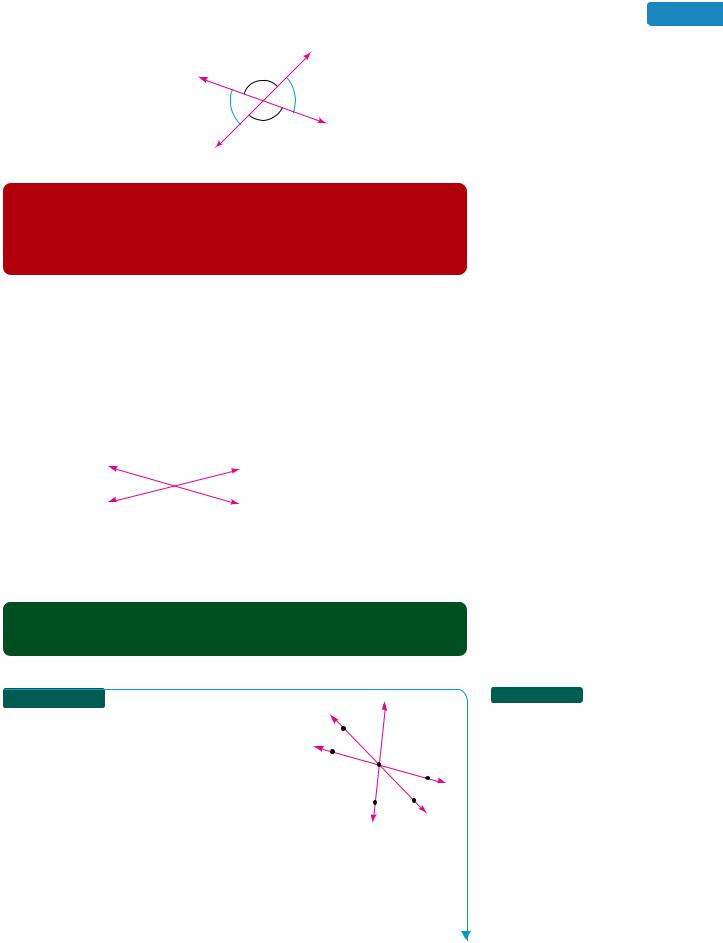
9.1 Basic Geometric Figures; Angles |
717 |
Vertical angles |
l1 |
|
|
|
1 |
||
|
|
||
• 1 and 3 |
2 |
4 |
|
3 |
|||
|
|
||
• 2 and 4 |
|
|
|
|
l2 |
|
The Language of Mathematics When we work with two (or more) lines at one time, we can use subscripts to name the lines. The prefix sub means below or beneath, as in submarine or subway. To name the first line in the figure above, we use l1, which is read as “l sub one.” To name the second line, we use l2, which is read as “l sub two.”
To illustrate that vertical angles always have the same measure, refer to the figure below, with angles having measures of x, y, and 30°. Since the measure of any straight angle is 180°, we have
30 x 180° |
and |
30 y 180° |
|
x 150° |
|
y 150° To undo the addition of 30°, |
|
|
|
|
subtract 30° from both sides. |
Since x and y are both 150°, we conclude that x y. |
|||
l2 |
|
x |
Note that the angles |
|
|
||
|
|
having measures x and y |
|
|
|
30° |
|
l1 |
|
y |
are vertical angles. |
|
|
||
The previous example illustrates that vertical angles have the same measure. Recall that when two angles have the same measure, we say that they are congruent. Therefore, we have the following important fact.
Property of Vertical Angles
Vertical angles are congruent (have the same measure).
|
EXAMPLE 3 |
Refer to the figure. Find: |
|
|
|
|||
|
|
A |
|
|||||
a. m( 1) |
b. m( ABF) |
|
|
|
||||
|
|
1 |
|
|||||
Strategy To answer part a, we will use the property |
|
2 |
||||||
|
|
|||||||
F |
B |
|
||||||
of vertical angles. To answer part b, we will write an |
E |
|||||||
100° |
||||||||
|
||||||||
|
|
|
|
|
|
|
||
equation |
involving |
m( ABF) that |
mathematically |
|
C 50° |
D |
||
models the situation. |
|
|
|
|||||
|
|
|
|
|||||
|
|
|
· |
· |
|
|
|
|
WHY For part a, we note that AD and BC intersect to |
|
|
|
|||||
|
|
|
||||||
form vertical angles. For part b, we can solve the equation to find the unknown, m( ABF).
Solution |
· · |
· |
a. If we ignore FE for the moment, we see that AD and BC intersect to form the pair of vertical angles CBD and 1. By the property of vertical angles,
CBD 1 Read as “angle CBD is congruent to angle one.”
 Self Check 3
Self Check 3
Refer to the figure for Example 3. Find:
a.m( 2)
b.m( DBE)
Now Try Problems 69 and 71
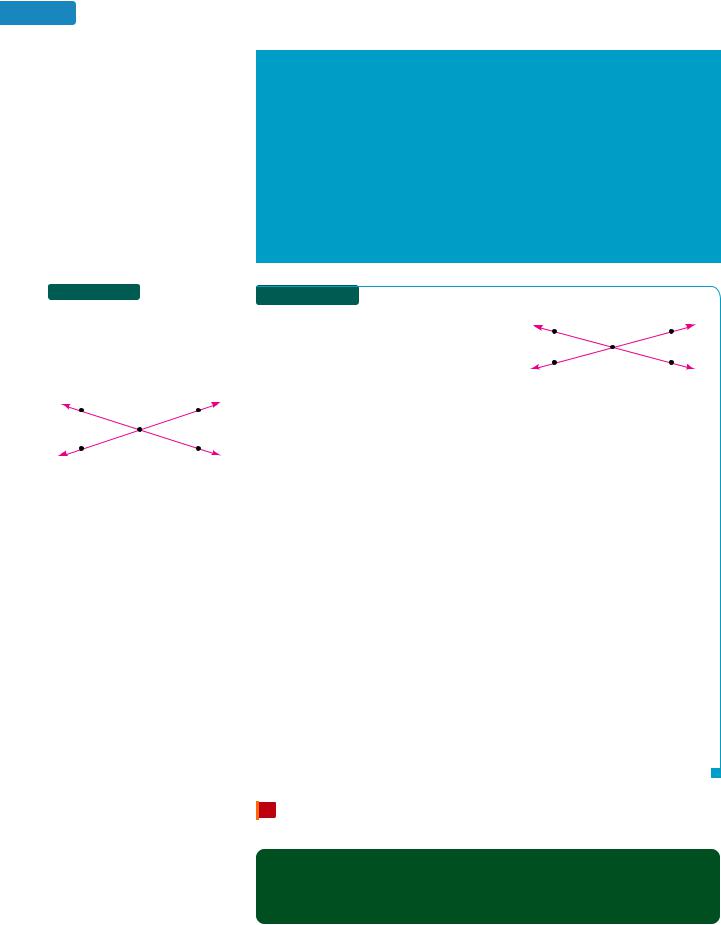
718 |
Chapter 9 An Introduction to Geometry |
Since congruent angles have the same measure,
m( CBD) m( 1)
In the figure, we are given m( CBD) 50°. Thus, m( 1) is also 50°, and we can write m( 1) 50°.
b.Since ABD is a straight angle, the sum of the measures of ABF, the 100° angle, and the 50° angle is 180°. If we let x m( ABF), we have
x100° 50° 180° The word sum indicates addition.
x 150° 180° On the left side, combine like terms: 100° 50° 150°.
x 30° To isolate x, undo the addition of 150° by subtracting 150° from both sides: 180° 150° 30°.
Thus, m( ABF) 30°
 Self Check 4
Self Check 4
In the figure below, find:
a.y
b.m( XYZ)
c.m( MYX)
X |
M |
4y − 10° |
2y + 20° |
|
Y |
Z |
N |
Now Try Problem 75
|
EXAMPLE 4 In the figure on the right, find: |
|
|
|
||
a. x b. m( ABC) c. m( CBE) |
|
|
|
|
||
|
|
3x + 15° |
|
|||
Strategy |
We will use the property of vertical |
|
A |
|
C |
|
|
|
B |
|
|||
angles to write an equation that mathematically |
|
|
|
|||
|
D |
4x − 20° |
E |
|||
models the situation. |
|
|||||
|
|
|
|
|||
· |
· |
|
|
|
|
|
WHY AE and DC intersect to form two pairs of vertical angles. |
|
|||||
Solution
a.In the figure, two vertical angles have degree measures that are represented by the algebraic expressions 4x 20° and 3x 15°. Since the angles are vertical angles, they have equal measures.
4x 20° 3x 15° Set the algebraic expressions equal.
4x 20° 3x 3x 15° 3x To eliminate 3x from the right side, subtract
|
3x from both sides. |
x 20° 15° |
Combine like terms: 4x 3x x |
|
and 3x 3x 0. |
x 35° |
To isolate x, undo the subtraction of |
|
20° by adding 20° to both sides. |
Thus, x is 35°.
b. To find m( ABC), we evaluate the expression 3x 15° for x 35°.
3x 15° 3(35 ) 15° |
Substitute 35° for x. |
|
1 |
|
|||
105° 15° |
Do the multiplication. |
|
35 |
|
3 |
||
120° |
Do the addition. |
|
105 |
|
Thus, m( ABC) 120°.
c.ABE is a straight angle. Since the measure of a straight angle is 180° and m( ABC) 120°, m( CBE) must be 180° 120°, or 60°.
7Solve problems involving complementary and supplementary angles.
Complementary and Supplementary Angles
Two angles are complementary angles when the sum of their measures is 90°.
Two angles are supplementary angles when the sum of their measures is 180°.
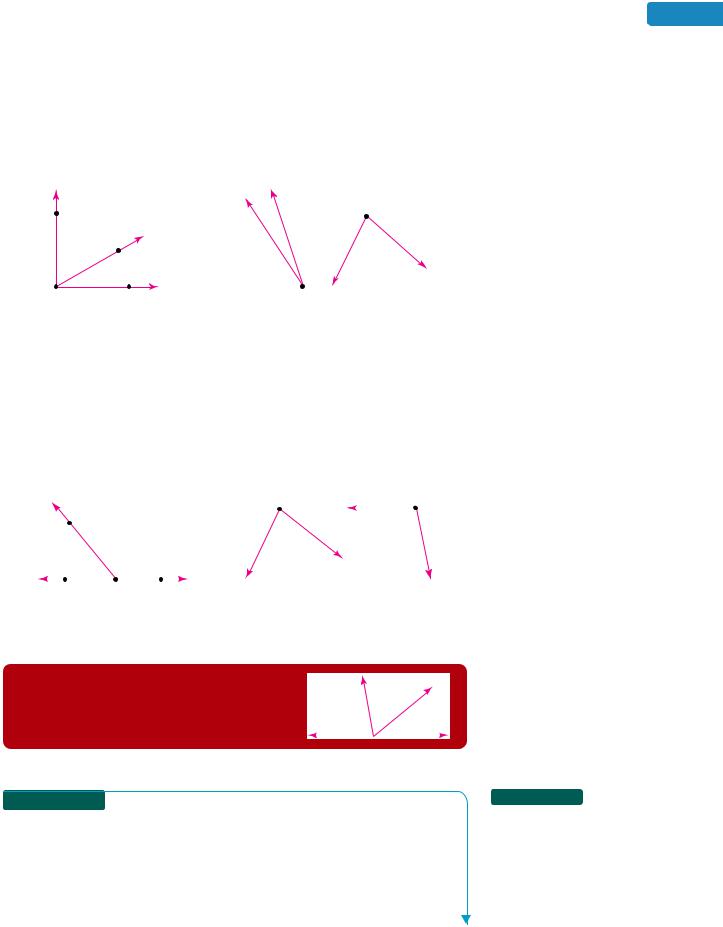
9.1 Basic Geometric Figures; Angles |
719 |
ABC CBD
of their measures is 90°. Each angle is said to be the complement of the other. In figure (b) below, X and Y are also complementary angles, because m( X) m( Y) 90°. Figure (b) illustrates an important fact: Complementary angles need not be adjacent angles.
Complementary angles
A |
C |
60° |
30° |
B |
D
60° + 30° = 90°
(a)
15° |
Y |
|
75°
X |
15° + 75° = 90°
(b)
In figure (a) below, MNO and ONP are supplementary angles because the sum of their measures is 180°. Each angle is said to be the supplement of the other. Supplementary angles need not be adjacent angles. For example, in figure (b) below,G and H are supplementary angles, because m( G) m( H) 180°.
Supplementary angles
|
|
|
G |
|
|
H |
O |
|
78° |
102° |
|
||
|
|
|
||||
|
|
|
|
|
||
50° |
130° |
|
|
|
|
|
M |
N |
P |
|
|
|
|
50° + 130° = 180° |
|
|
78° + 102° = 180° |
|
||
|
(a) |
|
|
(b) |
||
Caution! The definition of supplementary angles requires that the sum of two angles be
180°. Three angles of 40°, 60°, and 80° are not |
|
60° |
|
80° |
40° |
||
supplementary even though their sum is 180°. |
 EXAMPLE 5
EXAMPLE 5
a.Find the complement of a 35° angle.
b.Find the supplement of a 105° angle.
Strategy We will use the definitions of complementary and supplementary angles to write equations that mathematically model each situation.
WHY We can then solve each equation to find the unknown angle measure.
 Self Check 5
Self Check 5
a.Find the complement of a 50° angle.
b.Find the supplement of a 50° angle.
Now Try Problems 77 and 79
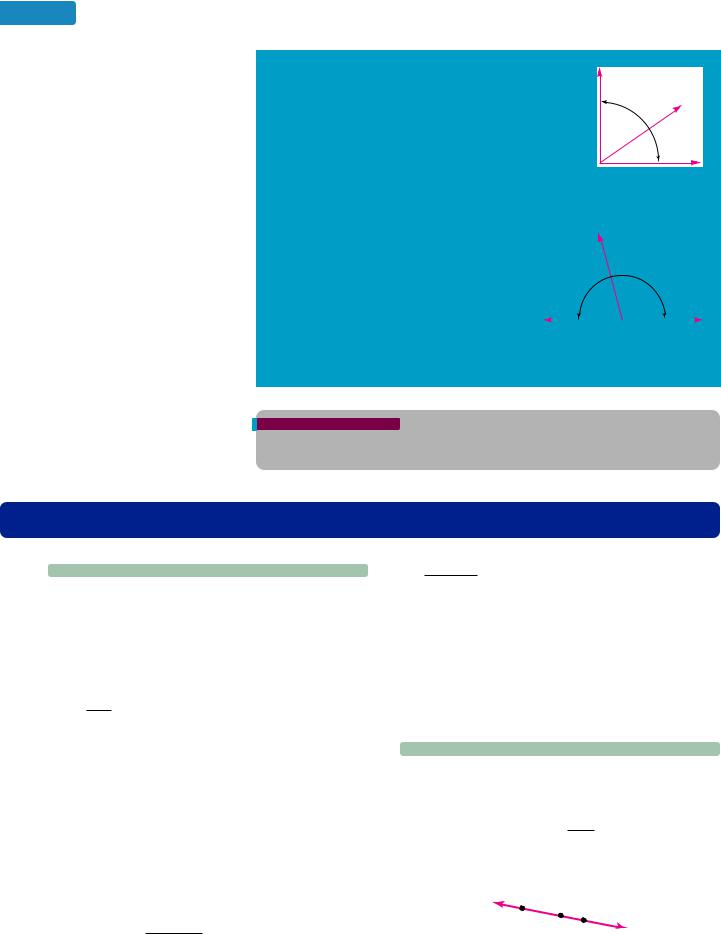
720 |
Chapter 9 An Introduction to Geometry |
Solution
a.It is helpful to draw a figure, as shown to the right. Let x represent the measure of the complement of the 35° angle. Since the angles are complementary, we have
x 35° 90° The sum of the angles’ measures must be 90°.
x 55° To isolate x, undo the addition of 35° by subtracting 35° from both sides: 90° 35° 55°.
90° |
x |
35° |
The complement of a 35° angle has measure 55°.
b. It is helpful to draw a figure, as shown on the |
|
|
|
|
|
right. Let y represent the measure of the |
|
|
|
|
|
supplement of the 105° angle. Since the angles |
|
|
180° |
|
|
are supplementary, we have |
|
|
|
||
|
|
|
|
||
y 105° 180° |
The sum of the angles’ |
|
|
y 105° |
|
y 75° |
measures must be 180°. |
|
|
|
|
|
|
|
|
||
|
|
|
|
||
To isolate y, undo the addition of 105° by subtracting |
|||||
|
105° from both sides: 180° 105° 75°. |
|
|
||
The supplement of a 105° angle has measure 75°.
ANSWERS TO SELF CHECKS
1. |
right angle, obtuse angle, acute angle, straight angle 2. 35° 3. a. 100° b. 30° |
4. |
a. 15° b. 50° c. 130° 5. a. 40° b. 130° |
|
S E C T I O N |
9.1 STUDY SET |
|
|
|
|
|
||||||||
|
|
VOCABULARY |
|
|
|
|
|
|
|||||||
|
|
|
|
|
|
|
|||||||||
|
|
|
|
|
|
|
|||||||||
|
Fill in the blanks. |
|
|
|
|
|
|
|
|
|
|||||
|
1. |
Three undefined words in geometry are |
, |
|
, |
||||||||||
|
|
|
and |
|
. |
|
|
|
|
|
|
|
|
||
|
2. |
A line |
|
|
|
has two endpoints. |
|
|
|
|
|
||||
|
3. |
A |
|
|
divides a line segment into two parts of |
|
|
||||||||
equal length.
4.A is the part of a line that begins at some point and continues forever in one direction.
5. |
An |
|
is formed by two rays with a common |
||||||||||||
|
endpoint. |
|
|
|
|
|
|
|
|
|
|
|
|
||
6. |
An angle is measured in |
|
|
. |
|
|
|||||||||
7. |
A |
|
|
is used to measure angles. |
|
||||||||||
8. |
The measure of an |
|
|
|
angle is less than 90°. |
||||||||||
9. |
The measure of a |
|
|
angle is 90°. |
|
||||||||||
10. |
The measure of an |
|
|
|
|
angle is greater than 90° |
|||||||||
|
but less than 180°. |
|
|
|
|
|
|
|
|||||||
11. |
The measure of a straight angle is |
|
. |
||||||||||||
12. When two segments have the same length, we say that they are .
13.angles have the same vertex, are side-by- side, and their interiors do not overlap.
14.When two lines intersect, pairs of nonadjacent angles
|
are called |
|
|
angles. |
|
|
|||||
15. |
When two angles have the same measure, we say that |
||||||||||
|
they are |
|
|
. |
|
|
|
|
|
||
16. |
The word sum indicates the operation of |
|
. |
||||||||
17. |
The sum of two complementary angles is |
|
|
. |
|
||||||
18. |
The sum of two |
|
|
|
angles is 180°. |
|
|
||||
 CONCEPTS
CONCEPTS
19.a. Given two points (say, M and N), how many different lines pass through these two points?
b. Fill in the blank: In general, two different points determine exactly one .
20. Refer to the figure.
¡
a. Name NM in another way.
¡ ¡
b. Do MN and NM name the same ray?
N
M C
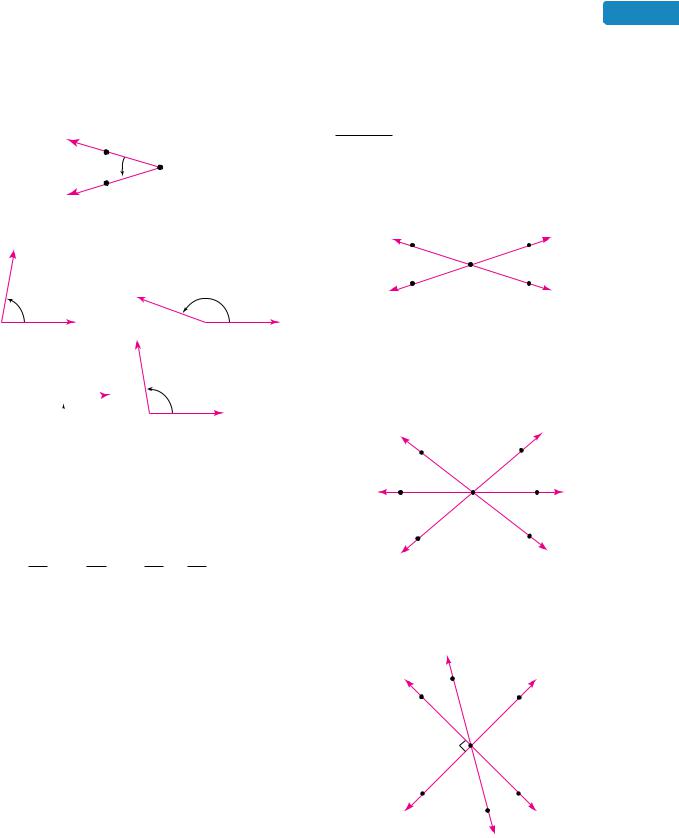
21.Consider the acute angle shown below.
a.What two rays are the sides of the angle?
b.What point is the vertex of the angle?
c.Name the angle in four ways.
R
1 |
S |
T
22.Estimate the measure of each angle. Do not use a protractor.
a. b.
c.  d.
d.
23. Draw an example of each type of angle.
a. |
an acute angle |
b. |
an obtuse angle |
c. |
a right angle |
d. |
a straight angle |
24.Fill in the blanks with the correct symbol.
a.If m(AB) m(CD), then AB  CD.
CD.
b.If ABC DEF, then m( ABC)  m( DEF).
m( DEF).
25.a. Draw a pair of adjacent angles. Label them ABC and CBD.
b.Draw two intersecting lines. Label them lines l1 and l2. Label one pair of vertical angles that are formed as 1 and 2.
c.Draw two adjacent complementary angles.
d.Draw two adjacent supplementary angles.
9.1 Basic Geometric Figures; Angles |
721 |
26.Fill in the blank:
If MNO BFG, then m( MNO)  m( BFG).
m( BFG).
27.Fill in the blank:
The vertical angle property: Vertical angles are
.
28.Refer to the figure below. Fill in the blanks.
a. |
XYZ and |
|
are vertical angles. |
|||
b. |
XYZ and ZYW are |
|
|
angles. |
||
c. |
ZYW and XYV are |
|
angles. |
|||
|
X |
|
|
Z |
||
|
|
|
Y |
|
|
|
|
V |
|
|
W |
||
29.Refer to the figure below and tell whether each statement is true.
a.AGF and BGC are vertical angles.
b.FGE and BGA are adjacent angles.
c.m( AGB) m( BGC).
d.AGC DGF.
A B
F G C
E D
30.Refer to the figure below and tell whether the angles are congruent.
a. |
1 and 2 |
b. FGB and CGE |
c. |
AGF and FGE |
d. CGD and CGB |
|
|
C |
|
B |
D |
|
1 |
|
|
|
G |
|
|
2 |
|
A |
E |
|
|
F |
Refer to the figure above and tell whether each statement is true.
31.1 and CGD are adjacent angles.
32.FGA and AGC are supplementary.
33.AGB and BGC are complementary.
34.AGF and 2 are complementary.
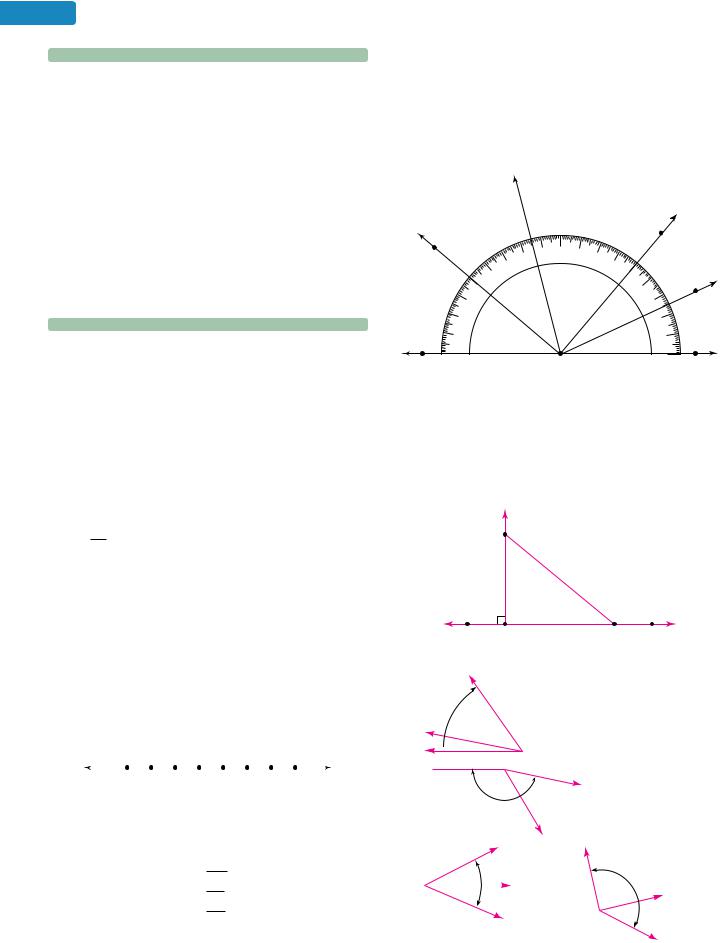
722 |
Chapter 9 An Introduction to Geometry |
|||||||||||||||||||||
|
|
NOTATION |
|
|
|
|
|
|
|
|
|
|
|
|
|
|
|
|
|
|
||
|
|
|
|
|
|
|
|
|
|
|
|
|
|
|
|
|
|
|
|
|||
|
Fill in the blanks. |
|
|
|
|
|
|
|
|
|
|
|
|
|
|
|
|
|
|
|||
35. |
|
|
· |
|
|
|
|
|
|
|
|
|
AB.” |
|||||||||
The symbol AB is read as “ |
|
|
|
|||||||||||||||||||
|
|
|
The symbol |
|
|
|
is read as “ |
|
|
|
|
|
AB.” |
|||||||||
36. |
AB |
|
|
|
|
|
||||||||||||||||
|
|
|
|
|
¡ |
|
|
|
|
|
|
|
|
|
|
|
|
|
|
|||
37. |
|
|
|
|
|
|
|
|
|
|
|
AB.” |
||||||||||
The symbol AB is read as “ |
|
|
|
|||||||||||||||||||
|
|
|
We read m( |
|
|
) as “the |
|
|
|
|
|
|
|
of segment AB.” |
||||||||
38. |
AB |
|
|
|
|
|
|
|
||||||||||||||
39. |
We read ABC as “ |
|
|
|
|
ABC.” |
||||||||||||||||
40. |
We read m( ABC) as “the |
|
|
|
|
|
|
of angle ABC.” |
||||||||||||||
41. |
The symbol for |
|
|
is a small raised circle, °. |
||||||||||||||||||
42. |
The symbol indicates a |
|
|
|
angle. |
|||||||||||||||||
|
|
|
||||||||||||||||||||
43. |
The symbol is read as “is |
|
|
|
|
|
|
|
to.” |
|||||||||||||
44. |
The symbol l1 can be used to name a line. It is read as |
|||||||||||||||||||||
|
|
|
“line l |
|
one.” |
|
|
|
|
|
|
|
|
|
|
|
||||||
 GUIDED PRACTICE
GUIDED PRACTICE
45.Draw each geometric figure and label it completely.
See Objective 1. a. Point T
·
b. JK
c. Plane ABC
46. Draw each geometric figure and label it completely.
See Objectives 2 and 3.
a. RS
¡
b. PQ
c. XYZ
d. L
47.Refer to the figure and find the length of each segment. See Objective 2.
|
|
|
|
A |
|
B |
C |
D |
|
|
|
E |
|
|
|
|
|
|
|
|
|
|
|
||||
|
2 |
3 |
4 |
5 |
6 |
|
7 |
8 |
9 |
||||
|
|
|
|
|
|
|
|
|
|
|
|
|
|
a. |
AB |
|
|
|
|
b. |
|
CE |
|
|
|||
|
|
|
|
|
|
|
|
|
|
|
|
|
|
c. |
DC |
|
|
|
|
d. |
|
EA |
|
|
|||
48.Refer to the figure above and find each midpoint.
See Objective 2.
a.Find the midpoint of AD.
b.Find the midpoint of BE.
c.Find the midpoint of EA.
Use the protractor to find each angle measure listed below.
See Objective 4.
49. |
m( GDE) |
50. |
m( ADE) |
51. |
m( EDS) |
52. |
m( EDR) |
53. |
m( CDR) |
54. |
m( CDA) |
55. |
m( CDG) |
56. |
m( CDS) |
 R
R
A G
160 |
150 |
30 |
20 |
|
|
170 |
10 |
|
140 |
40 |
|
130 50
120 60
110 70
100 80
90 |
80 |
|
100 |
70 110
60 120
50 130 40 140
30
150
20 160
17010
S
180 |
0 |
180 |
0 |
C |
|
D |
E |
Classify the following angles in the figure as an acute angle, a right angle, an obtuse angle, or a straight angle. See Example 1.
57. |
MNO |
58. |
OPN |
59. |
NOP |
60. |
POS |
61. |
MPQ |
62. |
PNO |
63. |
QPO |
64. |
MNQ |
S 
O
M N P Q
Find x. See Example 2.
65.
55°
45°
 x
x
66. 
112° x
168°
67. |
|
|
68. |
|
x |
50° |
130° |
|
|
||
|
|
|
|
22.5° |
|
x |
|
|
|
|
40° |
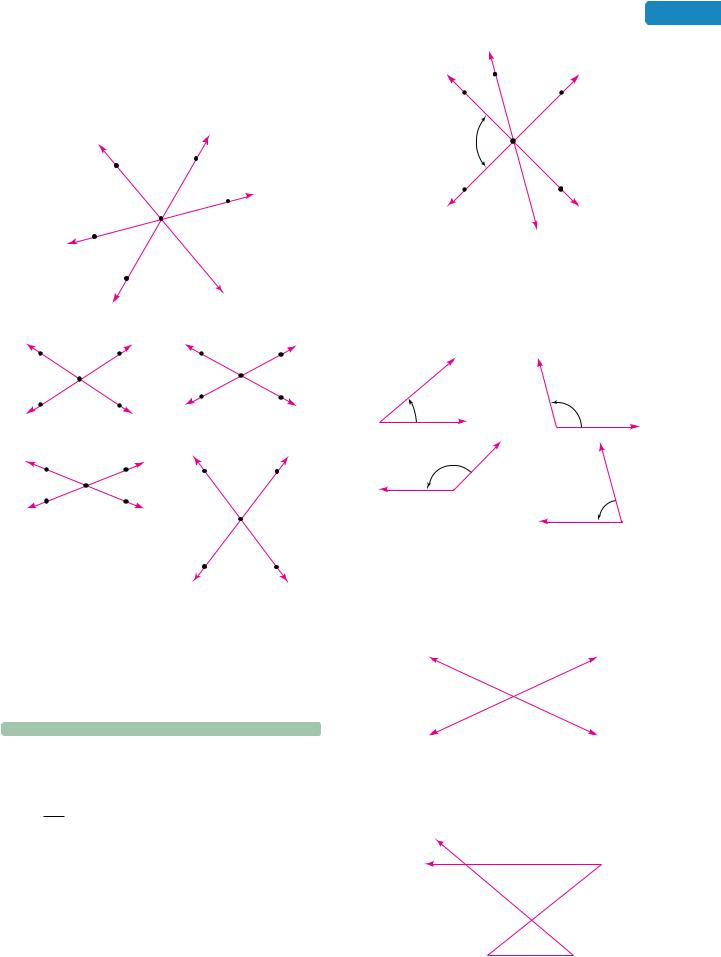
Refer to the figure below. Find the measure of each angle.
See Example 3.
69. |
1 |
70. |
|
MYX |
71. |
NYZ |
72. |
|
2 |
|
X |
|
|
T |
|
|
1 |
2 |
|
|
|
|
N |
|
|
|
|
|
|
|
M |
Y |
|
|
45°
70°
 Z
Z
O
First find x. Then find m( ABD) and m( DBE).See Example 4.
73. |
A |
C |
74. |
A |
C |
|
|
B |
|
|
B |
|
2x |
|
6x + 8° |
4x + 32° |
|
|
x + 30° |
|
|||
|
D |
E |
|
D |
E |
|
|
|
|
First find x. Then find m( ZYQ) and m( PYQ). See Example 4.
75. |
X |
4x + 15° |
P |
76. |
|
|
|
|
X |
P |
|
|
|
Y |
|
||
|
|
|
|
6x − 5° |
|
|
|
|
|
|
|
|
Z |
7x − 60° Q |
|
Y |
|
|
|
|
|
Z |
2x + 35° |
|
|
|
|
Q |
|
Let x represent the unknown angle measure. Write an equation and solve it to find x. See Example 5.
77.Find the complement of a 30° angle.
78.Find the supplement of a 30° angle.
79.Find the supplement of a 105° angle.
80.Find the complement of a 75° angle.
 TRY IT YOURSELF
TRY IT YOURSELF
81.Refer to the figure in the next column and tell whether each statement is true. If a statement is
false, explain why.
¡
a. GF has point G as its endpoint.
b. AG has no endpoints.
·
c. CD has three endpoints.
d. Point D is the vertex of DGB.
e. m( AGC) m( BGD) f. AGF BGE
9.1 |
Basic Geometric Figures; Angles |
723 |
||
|
C |
|
|
|
A |
30° |
60° |
F |
|
|
|
|
||
|
|
|
|
|
90° |
G |
90° |
|
|
|
|
|
|
|
E |
60° |
30° |
B |
|
|
|
|||
D 
82.Refer to the figure for Problem 81 and tell whether each angle is an acute angle, a right angle, an obtuse angle, or a straight angle.
a. |
AGC |
b. |
EGA |
c. |
FGD |
d. |
BGA |
Use a protractor to measure each angle. |
|
||
83. |
|
84. |
|
85. 86.
87.Refer to the figure below, in which m( 1) 50°. Find the measure of each angle or sum of angles.
a.3
b.4
c.m( 1) m( 2) m( 3)
d.m( 2) m( 4)
2
1 3
4
88.Refer to the figure below, in which m( 1) m( 3) m( 4) 180°, 3 4, and 4 5. Find the
measure of each angle.
a. |
1 |
b. 2 |
c. |
3 |
d. 6 |
6
5
100°
2
1
3 4

724Chapter 9 An Introduction to Geometry
89.Refer to the figure below where 1 ACD,1 2, and BAC 2.
a.What is the complement of BAC?
b.What is the supplement of BAC?
A B
2
1
24°
D C
90.Refer to the figure below where EBS BES.
a.What is the measure of AEF?
b.What is the supplement of AET?
C
F 38°
T Q
B
E |
 S
S
 A
A
91.Find the supplement of the complement of a 51° angle.
92.Find the complement of the supplement of a 173° angle.
93.Find the complement of the complement of a 1° angle.
94.Find the supplement of the supplement of a 6° angle.
 APPLICATIONS
APPLICATIONS
95.MUSICAL INSTRUMENTS Suppose that you are a beginning band teacher describing the correct posture needed to play various instruments. Using the diagrams shown below, approximate the angle measure (in degrees) at which each instrument should be held in relation to the student’s body.
a. flute |
b. clarinet |
c. trumpet |
96.PLANETS The figures below show the direction of rotation of several planets in our solar system. They also show the angle of tilt of each planet.
a.Which planets have an angle of tilt that is an acute angle?
b.Which planets have an angle of tilt that is an obtuse angle?
Pluto |
North 23.5° Earth |
122.5° |
Pole |
|
North 
Pole
26.7° |
Saturn |
Venus |
North |
|
177.3° |
Pole |
|

 North
North
Pole
97.a. AVIATION How many degrees from the horizontal position are the wings of the airplane?
63°
Horizontal
b.GARDENING What angle does the handle of the lawn mower make with the ground?
150°
98. SYNTHESIZER Find x and y.
115°
 x
x
y
